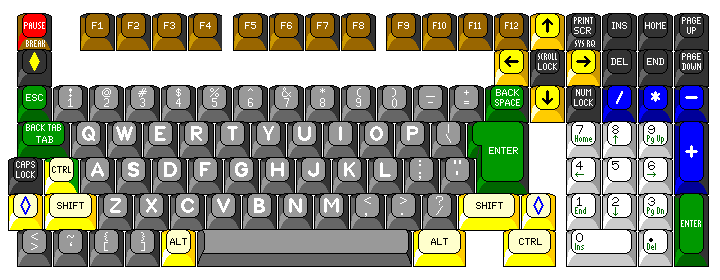
One personal preference I have when it comes to keyboards is to have the kind of large Enter key that was originally used with electric typewriter keyboards. But because the right and left square bracket are not on the same key in the IBM PC layout, this is difficult to achieve. Here is a compact keyboard layout that does achieve this for a 105-key keyboard with the international key and the Windows menu and shift keys:

Moving the left Control key to its traditional position, as well as shortening the space bar and moving the left Alt key over, allows the {[ and }] keys to be side by side while moved out of the way. The Esc key is moved to its traditional location within the main keyboard area proper as well, and the Pause/Break key is moved to its former location. As that key, as a key which interrupts a running program, should properly be red, perhaps this will permit the construction of a layout which appeals to people with a fondness for the famous red Esc key.
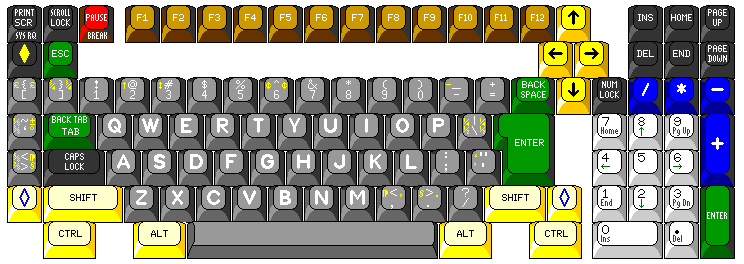
However, on further reflection, it was possible to find, at the cost of allowing the keyboard to become slightly wider, an even better location to put the {[ and }] keys next to each other, as shown above: make the keyboard one key wider to the left, thus replacing the ~` key by the second of those two keys.

The additional space need not even be considered wasted; it could be used to include the additional keys from the Japanese keyboard.
Incidentally, while it is not immediately apparent from the diagram, some of the keys have been moved from their corresponding positions. Thus, here is a diagram of the scan codes in the first keyboard:
------- --------------- --------------- -----------------------------------
|+45|-5D| | 3B| 3C| 3D| 3E|| 3F| 40| 41| 42|| 43| 44| 57| 58|*4C|+37|*52|*47|*49|
-------| --------------- --------------- -----------------------------------|
| 01| |*4B|+46|*4D|*53|*4F|*51|
--------------------------------------------------------------------------------|
| 2B| 1A| 02| 03| 04| 05| 06| 07| 08| 09| 0A| 0B| 0C| 0D| 0E|*50|+45|+35|+37| 4A|
|----------------------------------------------------------------|---------------|
| 29| 0F| 10| 11| 12| 13| 14| 15| 16| 17| 18| 19| 1B| | | 47| 48| 49| |
|------------------------------------------------------ 1C| |-----------| 4E|
| 2A| 3A| 1E| 1F| 20| 21| 22| 23| 24| 25| 26| 27| 28| | | 4B| 4C| 4D| |
--------------------------------------------------------------- |---------------|
|-5B| 56| 2C| 2D| 2E| 2F| 30| 31| 32| 33| 34| 35| 36|-5C|| 4F| 50| 51| |
--------------------------------------------------------------- |-----------|-1C|
| 1D| | 38| 39| -38| | -1D| | 52| 53| |
----- ------------------------------------- ----- ---------------
and one for the Japanese version:
------- --------------- --------------- ----------------------------------- |+45|-5D| | 3B| 3C| 3D| 3E|| 3F| 40| 41| 42|| 43| 44| 57| 58|*4C|+37|*52|*47|*49| |------- --------------- --------------- -----------------------------------| | 73| 01| |*4B|+46|*4D|*53|*4F|*51| |--------------------------------------------------------------------------------| | 1B| 2B| 02| 03| 04| 05| 06| 07| 08| 09| 0A| 0B| 0C| 0D| 0E|*50|+45|+35|+37| 4A| |--------------------------------------------------------------------------------| | 29| 0F| 10| 11| 12| 13| 14| 15| 16| 17| 18| 19| 1A| | 79| 47| 48| 49| | |------------------------------------------------------ 1C|---------------| 4E| | 7D| 3A| 1E| 1F| 20| 21| 22| 23| 24| 25| 26| 27| 28| | 70| 4B| 4C| 4D| | --------------------------------------------------------------------------------| |-5B| 56| 2C| 2D| 2E| 2F| 30| 31| 32| 33| 34| 35| 36|-5C|| 4F| 50| 51| | |--------------------------------------------------------------- |-----------|-1C| | 7B| 1D| | 38| 39| -38| | -1D| | 52| 53| | --------- ------------------------------------- ----- ---------------
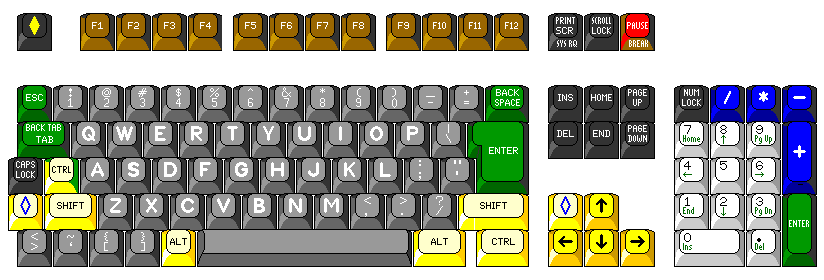
As a compact keyboard with a numeric keypad like the one above may be considered too cramped, one might give up on making the keyboard more compact, and instead accept making it a little wider, while keeping the innovation of having the {[ and }] keys out of the way and yet side by side.

And a similar layout, but one that attempts to keep the return of the left-hand Control key to its traditional spot (by separating it from the Reset key of the 122-key layout, since hitting that by accident would be worse than hitting Caps Lock by accident), and which attempts to have all the keys found on the Sun layout and the 122-key layout, is shown below:
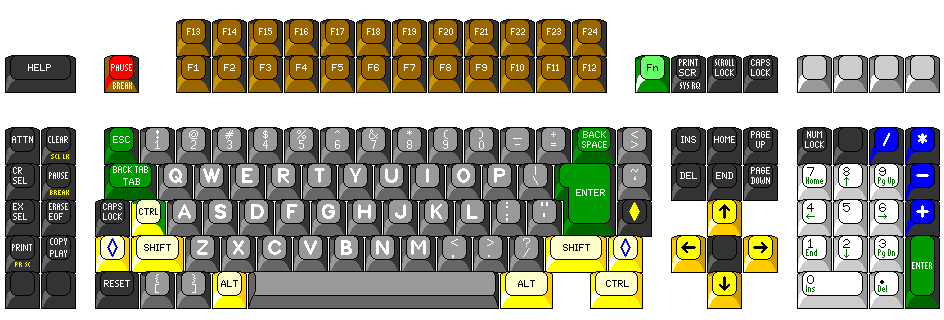
And here is a compact arrangement for the keys of the normal keyboard, with just enough extra to emulate other arrangements at need:
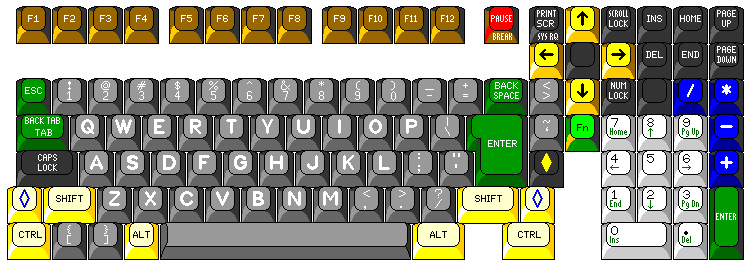
The original PC keyboard was more compact than the modern 101-key keyboard because it used the same keys for the numeric keypad and the cursor keypad. This was something of an inconvenience to spreadsheet users, but as there are many who would seek a more compact keyboard at the price of eliminating the numeric keypad altogether, it would still appear that this strategy could be useful.
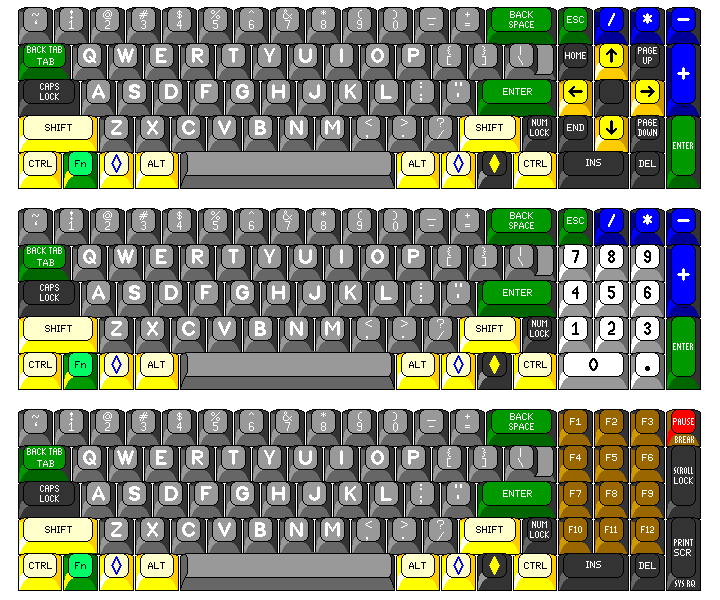
In the illustration above, the priciple is taken even further, to allow a more compact keyboard by using the Fn key to make the numeric keypad serve a third purpose, as a function keypad. Note that the Num Lock key was moved away from the numeric keypad, since it seemed unfitting to use one of the two keys that control how the numeric keypad is used as one of the keys that is changed in purpose, to become a function key. So the Esc key replaces it, taking a position similar to the one it had in the 84-key AT keyboard.
The first diagram, then, shows the keyboard's normal state; the second, when Num Lock is in effect, and the third, when the Fn key is held down.
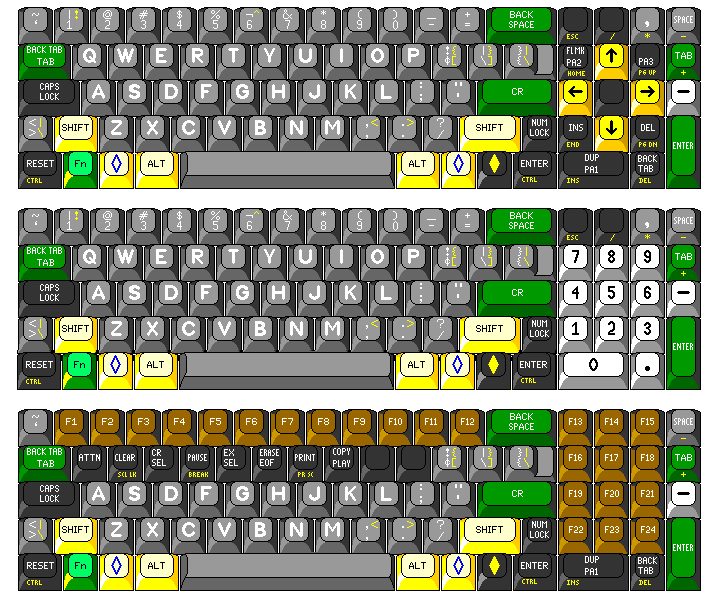
The illustration above shows how the addition of only two additional keys could even allow this type of keyboard to substitute for a 122-key keyboard, and this particular arrangement of function keys matches one used with the IBM 3278 display station.
This principle of allowing the keys on the keyboard to perform double duty could be taken even further, to allow even the numeric keypad to be eliminated, in addition to the cursor keys and the function keys. The Happy Hacking Keyboard from Fujitsu functions in this manner.
Copyright (c) 2007, 2009 John J. G. Savard